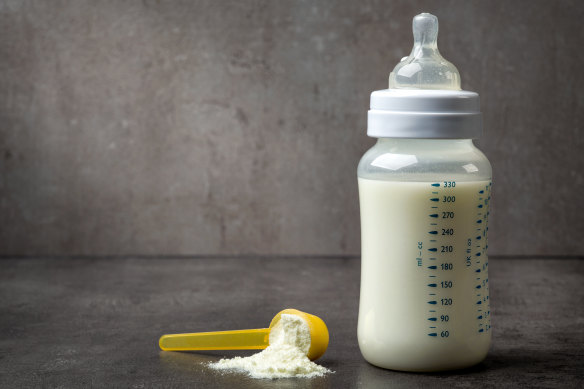[ad_1]
Loading
She said animal milk was readily accessible, while formula supply chains were sometimes disrupted, which made it difficult for families to access their preferred formula.
Hull advised parents to speak to their GP, maternal child health nurse or dietitian before making any changes to their children’s diets.
“It depends on individual circumstances,” she said. “It’s what’s affordable, what’s safe and what is accessible.”
The Australian Health Department and WHO both recommend exclusive breastfeeding for the first six months of a baby’s life and then continued breastfeeding with solid food until a child turns two.
WHO experts examined nine studies, mainly conducted in high-income countries, before publishing updated guidelines in October.
They found no significant difference in weight gain for babies who drank cow’s milk compared with those on formula.

The Australian government and the World Health Organisation both recommend exclusive breastfeeding for the first six months of life.Credit: Shutterstock
But they acknowledged that cow’s milk might increase the risk of anaemia due to “low certainty evidence” it might lead to bleeding in the gut for some children. The experts said iron deficiency could be avoided by feeding babies iron-rich foods or supplements.
“Every country needs to consider the WHO guidance and make the decisions that are most appropriate in their own context,” a WHO spokesman told this masthead.
He said the UN health agency’s stance had not changed since 2007, but there was confusion because the previous guidelines encompassed all non-breastfed and mixed-fed (those who consume formula and breast milk) infants between six and 24 months old.
The new guidelines are explicitly for non-breastfed and mixed-fed infants aged six to 11 months. “We felt it was important to clarify the issue,” the spokesman said.

The Infant Nutrition Council, which represents Australia’s infant formula manufacturers and importers, is concerned by the change in advice.Credit: Getty Images
An Australian Health Department spokesman said animal milks were a poor source of iron and affected an infant’s ability to absorb iron from other foods.
“Infant formula products that are based on animal milks are specially formulated and fortified with iron, thus are the only safe alternative to breastmilk while introducing foods to the infant diet,” the spokesman said.
He said the department monitored new and emerging evidence around infant feeding and would update its guidelines if necessary.
Nicole Bando, a co-convenor of Dietician Australia’s breastfeeding and nutrition working group, said Australia’s infant feeding guidelines, which were released in 2012, should be revised.

Lauren Caulfield’s youngest son, nine-month-old Elias, drinks an infant formula for babies with sensitive stomachs.Credit: Eddie Jim
“There is new and compelling evidence to strengthen recommendations for many aspects of infant feeding, including breastfeeding, the age of solids introduction to six months, allergy prevention messaging, responsive feeding, and the option to include cow’s milk as an alternative to infant formula in non-breastfed children from the age of six months,” she said.
Bando said the WHO guidelines were evidence-based and free from industry influence. But she said it was important to remember the organisation made a global recommendation.
“In many countries where there is a lack of access to sanitation, including clean drinking water, animal milk may be safer than formula,” she said.
Loading
But the Infant Nutrition Council, which represents Australia’s infant formula manufacturers and importers, is concerned by the WHO’s advice.
“[It] contradicts scientific evidence that animal milk, including cow’s milk, is not suitable as the main drink for infants under the age of 12 months,” said the council’s chief executive, Jonathan Chew.
Chew said technical experts at his organisation were reviewing the guidelines and would share their findings with the Commonwealth.
Lauren Caulfield exclusively breastfed both her children until they were six months old before switching to mixed-feeding, and then solely formula when they were about nine months old.
Loading
She said transitioning to cow’s milk at six months would have been a great, affordable option for her eldest son, Aziah, who is now three, but would not have worked for her youngest son, Elias, who is nine months old.
“He has a bit of an intolerance to dairy,” said Caulfield, from Officer in Melbourne’s south-east. “I am giving him a dairy formula, but it is for sensitive tummies … giving him straight cow’s milk would be cheaper but harsher on his belly.”
Caulfield spends about $40 on a tin of formula, which lasts six days.
The Morning Edition newsletter is our guide to the day’s most important and interesting stories, analysis and insights. Sign up here.
[ad_2]
Source link

